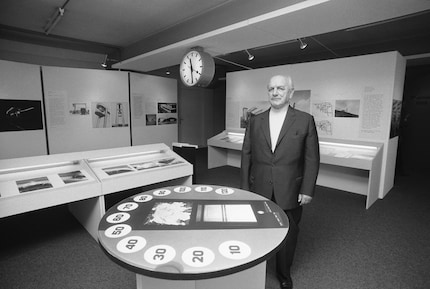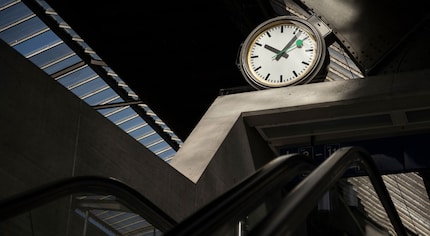

The moment Switzerland stands still
The SBB clock is a bona fide icon. And that includes the red second hand, which pauses just before every full minute. But why exactly does this happen?
It’s 3:51 p.m. I’m waiting on platform 4 at Visp station for the IC6 bound for Bern. The train should arrive in a minute. I glance at the clock on the platform: the second hand is approaching 12. But instead of the clock jumping to 3:52 p.m., everything stops for a moment. 3:51:00. What’s going on?
A moment later, the minute hand moves to 52 and the second hand starts ticking again. The train arrives on schedule, all according to plan.
If you’ve ever looked at the iconic SBB clock for more than 60 seconds, you’ll have noticed this too. At the top of every minute, it all comes to a standstill for a tiny moment. Then, the minute hand jumps forward abruptly and everything continues as if nothing had ever happened. But why this delay? After all, the Swiss train network is generally known for its punctuality.
How a design icon was born
To find out where this jerkiness comes from, we have to turn the clock back a few years. The now-legendary station clock was developed in 1944 by Swiss engineer and designer Hans Hilfiker. No red second hand back then mind you, that was only added years later. Hilfiker deliberately kept the entire layout simple so that the clock would remain easy to read even from a great distance.

Source: ETH library Zürich, picture archive/Marcel Vogt
The second hand, which was added later, is reminiscent of the trowel used by station staff in the old days. Today, the simple design is known worldwide as a symbol of Switzerland and its reliable train system. Today, the clock is built in Sumiswald by manufacturer Moser-Bär, which incidentally is also responsible for the famous horn on post buses. The design is now available in wristwatches and wall clocks from Swiss manufacturer and licence holder Mondaine.
In 2012, Apple even copied our SBB watch onto the iPad – without asking for permission first. Although SBB didn’t file a lawsuit, it reached an out-of-court settlement with Apple for a licence fee of a whopping 20 million francs.
How a hurdle became an icon
In any case, SBB had high standards for the punctuality of its clocks right from the start. The now more than 5000 station clocks throughout Switzerland shouldn’t just run accurately, but at the same time too. However, 80 years ago it wasn’t as easy to synchronise this many clocks to the second – a different approach was promptly chosen.
A separate clock system was installed at each station, each with a master clock and several secondary clocks. This meant that only the master clock had to set the time and send an impulse to all the other secondary clocks every full minute. The result? Long hands jumping forward every minute.

Source: SBB
But we still haven’t solved the second hand problem. Sending a pulse every second would’ve been far too tricky to set up at the time and would’ve worn out the system too quickly. For this reason, a separate synchronous motor was installed for the second hand, which was operated continuously and independently from the rest of the system. On the one hand, this ensured smooth movement for the second hand, but would lead to time deviations due to frequency fluctuations in the local alternating current.
To counteract this problem, the drive for the second hand was accelerated very slightly so that it’d complete one revolution in 58.5 seconds. Once at the top, the hand would lock into place next to a magnetic rod. Incidentally, fellow editor Carolin also experienced exactly this phenomenon a few years ago(/page/warum-eigentlich-stoppt-der-sekundenzeiger-der-bahnhofsuhr-21628). As soon as the minute pulse arrives, the rod’s released again and the second hand can continue to move. This ensured that all clocks would run in sync again at least every minute.
From shortcoming to trademark trick
Today, of course, synchronising all these clocks and eliminating the short break would be a piece of cake. However, just like its simple design, the peculiar minute jump has become a characteristic of Swiss station clocks. Even the purely digital mega-clock at Wankdorf station in Bern stops briefly every full minute.
Looking abroad, you quickly realise our station clock has set the bar, so to speak. Deutsche Bahn clocks, for example, aren’t only visually reminiscent of the SBB clock, but also directly adopt the stopping second hand. In Austria and Italy, too, the similarity of their clocks on tracks and at stations can’t be denied.
In my eyes, this short break also makes for some beautiful symbolism. Sometimes it’s worth stopping for a moment, taking a deep breath and only then moving on. Just like our iconic red second hand does every full minute.
I've been fascinated by all things keys, displays and speakers for basically as long as I can remember. As a journalist specialising in technology and society, I strive to create order in the jungle of tech jargon and confusing spec sheets.
Interesting facts about products, behind-the-scenes looks at manufacturers and deep-dives on interesting people.
Show all



